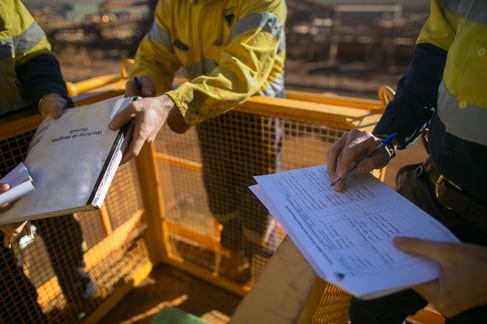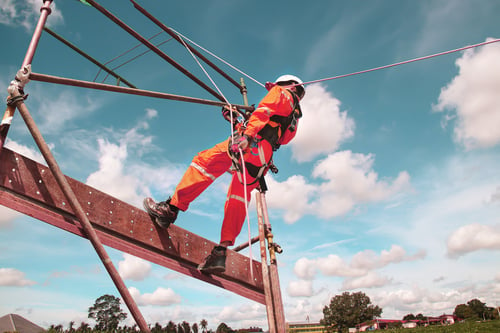10 Tips for Holding a Safety Stand-Down
Construction is a dangerous industry; workers are susceptible to injury because they face a wide range of hazards on job sites. The most common injuries in the construction industry stem from collapsed scaffolding, falling from heights, electrocution, failing to use correct protective gear, and collapsing trenches.
Occupational Safety and Health Administration (OSHA) under the US Department of Labor states that in 2017, there were 2.8 million nonfatal workplace illnesses and injuries that were reported by private industry employers. The leading cause of death is from falls. These fatal and nonfatal workplace injuries are preventable. Construction Managers are encouraged to hold safety stand-downs that work best for their job site or workplace. OSHA provides eight strategies for a successful stand-down. I have also included bonus tips for holding a safety stand-down.

Table of Contents
What is a Safety Stand-Down?
A Safety Stand-Down is a voluntary event for employers to talk to employees about safety. Workplaces can hold a safety stand-down when employers organize a break to hold a discussion with their employees about safety. Commonly, they highlight the opportunities for preventing workplace incidents, educating employees on the best practices, and reviewing hazards on job sites. Safety stand-downs are growing in popularity because they resolve and prevent injuries when done right. In other words, the breaks are known for having “toolbox talks,” which are informal discussions on a specific safety issue.
National Safety Stand-Down to Prevent Falls in Construction
In the past, OSHA has hosted employers, employees ranging from all aspects of construction attend to learn about how to conduct a stand-down and prevent hazards in the workplace. For example, commercial construction companies ranging from all sizes, general industry construction companies, highway construction companies, residential contractors, sub/independent contractors, etc. participated in past national stand-downs. Previously, 2.5 million workers attended OSHA’s National Safety Construction Stand-Down on Fall Prevention.
Mark your calendars! Because the next National Safety Construction Stand-Down is May 4-8, 2020.
1. Try to start early.
First and foremost, to prepare for a successful safety stand-down, try to plan and designate a coordinator to plan and organize when/where the safety stand-down will be. If you have multiple job-sites, identify which team members you want to lead the stand-down.

2. Ask all stakeholders on the jobsite to participate in a safety stand-down practice drill.
— 100% participation means better chances of not having an accident.
3. Review a fall prevention program:
What types of falls occur:
— from a roof
— from a structural steel
— through the floor
— from a ladder
— through a roof opening or fragile roof surface
— down the stairs
— from a scaffold
Some things to keep in mind when reviewing a fall prevention program: What needs improvement? Does your program meet its goals? Have you experienced injuries, fatalities, or almost mishaps? Are your employees knowledgable on the procedures of fall prevention?
— Are your employees trained? Does the training program need to be revised?
— Have you equipped your employees correctly? Is better equipment available?

4. Develop activities or presentations that will meet your goals.
Decide what information will be interpreted best by your employees and workers. The introduction should provide information about hazards, protective programs, and the company’s safety goals, policies, and expectations. Hands-on experience is beneficial for people to learn, so include a job-site walk or proper equipment checks.
5. Decide a time and duration of safety stand-down.
Without a doubt, safety is every construction project’s #1 priority, but on-time completion of a project is important. Decide if the stand-down will be during lunch, a break, or some other time, but try to accommodate the staff’s schedules.

6. Promote your safety stand-down.
Along with scheduling a time that is best for employees, try and make the stand-down engaging and valuable for the worker’s time. For instance, bring snacks, food, or refreshments, so the employees and workers are motivated to participate and pay attention.
7. Hold your safety stand-down.
In addition to promotion, try to make the safety stand-down positive, entertaining, and interactive. Not only can this act as a “team bonding” activity, but sharing stories and experiences can encourage workers and employees to make suggestions.

8. Follow up.
In terms of repetition, the more people hear and are told things, the more they retain that information. Keep stressing the safety points that the safety stand-down highlighted. Encouraging safety throughout the year on every project is essential because it becomes part of the staff’s work habits and becomes part of the company’s culture.
Bonus tips
9. Cover the basics.
Covering the basics deals with restating rules, guidelines, and procedures with equipment and materials for the construction site. Implementing a construction site safety checklist or conducting safety equipment inspections will establish a strong “safety culture” on job sites. Starting with the simplest things that make it easier for the workers to follow.
10. Visual aids.
Last but certainly not least, visual aids are another tip for a successful safety stand-down. People have different attention spans and are different learners. Visual aids in presentations have a significant impact on people. Maybe try including visuals of injuries, proper equipment, etc. will be useful in a presentation because they will capture the participants’ attention. To demonstrate safety prevention. In addition, visuals located around the jobsite are key for keeping safety top of mind.

Conclusion
Moreover, injuries and fatalities are costly. One workplace injury can put a detrimental dent or pause on a company’s profitability. Safety stand-downs are the leading tools to prevent injuries and fatalities for the construction industry. Above all, they raise awareness among workers and employees to help create a safe work environment.


